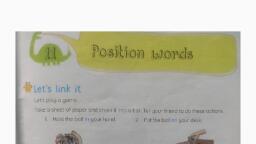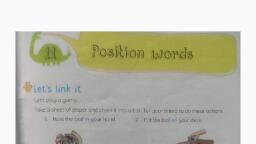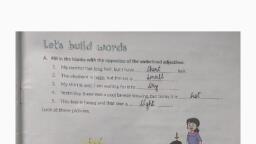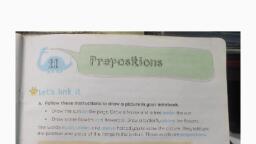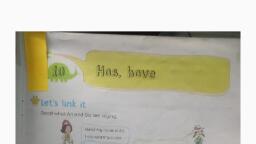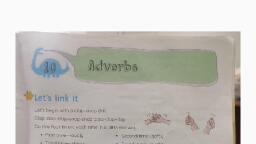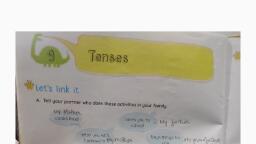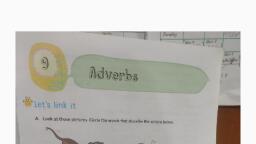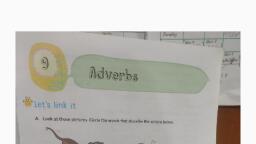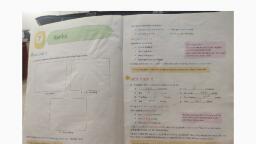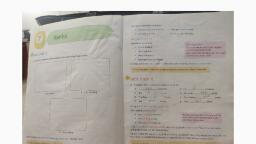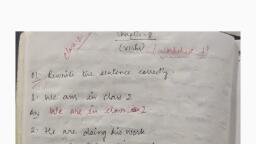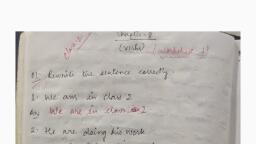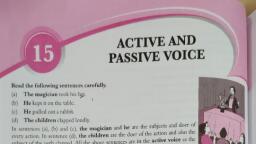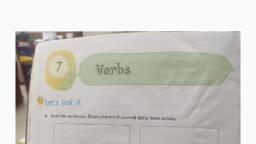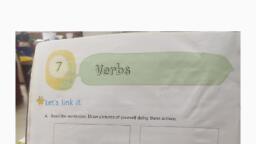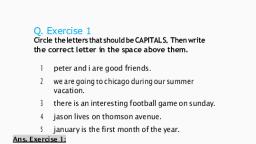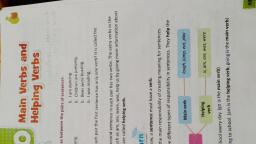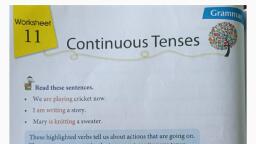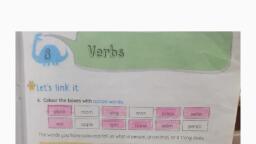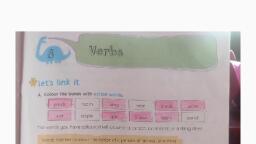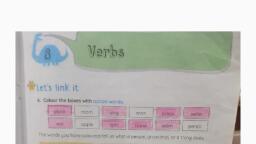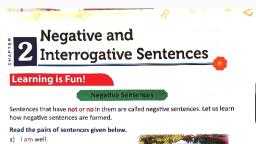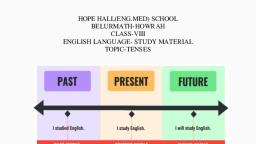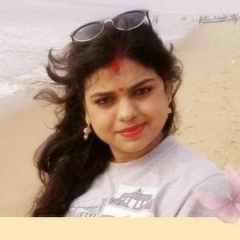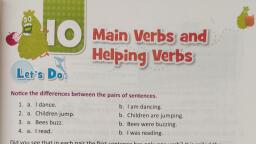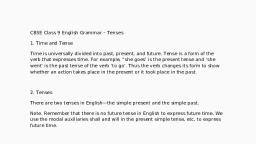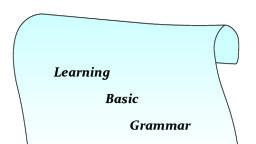Page 1 :
Verbs, Let's link it, A. Read the sentences. Draw pictures of yourself doing these actions., 1. I am running., 2. Iam sleeping., 3. I am eating., In the pictures you are running, sleeping, and eating. They are verbs., A verb expresses an action or state of being., 38
Page 2 :
Let's read some more examples., • Simran reads short stories., • We are building a hut., • I brush my teeth., • l eat an egg every day., Using am, is, and are, Read these sentences., Am is used with I., Is is used with he, she, it, and singular, common and proper nouns., Are is used with you, they, we, and plural, common and proper nouns., I am a student., • He is a doctor., We are friends., Sarah and Jaya are happy., In these sentences, am, is, and are show the state of being. They act as main verbs., A verb that shows the action or state of being in a sentence is called a main verb., Let's crack it, A. Complete these sentences using am, is, or are., 1. I_, am, a student., is, 2. He, a mason., 3. She, is, a pilot., 4. The walls, are, white., 5. The bag, heavy., 6. The children, are, pretty., 7. We, happy., 8. They, are, tired., Using am, is, and are with verb +-ing, Now read these sentences., I am learning about verbs., To show an action that takes place at the, time when we are talking about it, we, use -ing with the verb., He is writing a story., They are waiting for us., In these sentences, learning, writing, and waiting are the main verbs. They show the actions, taking place when we talk about them., Did you notice the use of is, am, and are in these sentences? Here they have been used with the, main verbs to complete the meaning of these sentences. They act as helping verbs., A verb used with the main verb to complete the meaning of a sentence is called a helping verb., 39
Page 3 :
B. Make sentences using words from each column. Write the sentences in your notebook., One has been done for you., gam mensling, 1. 1, writing., ane bleiping, 2., are, you, 2. You, sleeping., 3. She is sucimmming, 3. She, dancing., am, 4: He is playing, 4. He, is, playing., 5 we, are vookiing, 5. We-, are, swimming., 6. 94 is basking, biting, 6. It, barking., I: 2hey are däncing, 7. They, cooking., 1. Lam writing., C. The pictures below show what different people are doing. Fill in the blanks using these, pictures as clues. One has been done for you., 1. This is a cobbler. He, is mending, shoes., 2. These are porters. They re, LANNyong bags., 3. This is a mechanic. He b heppining car., Using have, has, and had, You have already learnt how to use have and has in sentences. Let us look at it again., 1. 1, 2. You, have, 3. We, an apple., 4. They, 5. He, has, 6. She, We use have and has when we want to show what belongs to a person,, an animal, or a thing. For example-, • I have a green chair., She has the storybook., 40
Page 4 :
D. Fill in the blanks with have or has to complete these sentences., have, 1. 1, a shelf full of books., have, has, has, have, have, 2. You, a basket of fruit., 3. He, a lovely garden., 4. She, many friends., 5. We, a sailboat., 6. They, a pet dog., Now read these pairs of sentences., I have a cold., I had a cold last week., She has a cold., She had a cold last week., • We have a test., We had a test yesterday., They have a test., They had a test yesterday., The first sentence in each pair talks about something that is taking place in the present, Therefore, we use have and has., The second sentence in each pair talks about something that happened in the past. Here we use, had. Had is the past tense of has and have., E. Complete, table using has / have or had. One has been done for you., Using has/ have, Using had, 1. I have a drawing class., I had a drawing class., 2. She has a fenver, She had a fever., dog, 3. We have a dog., me hada, 4. They have a holiday, They had a holiday., Using was and were, Read these sentences with was and were., I was tired., You were tired., We were happy., In these sentences, was and were act as main verbs., • When an action happens in the past, we use was and were., • We use was with singular nouns and were with plural nouns., We use was for collective nouns also. For example-, The team was happy., The bouquet of flowers was very beautiful., 41
Page 5 :
F. Tick () the correct sentence in each pair of sentences., 1. He was naughty., He were naughty., 2., We was excited to go on a picnic., We were excited to go on a picnic., 3., Were she hungry?, Was she hungry?, 4. Was I correct?, Were I correct?, 5. I were the class monitor., I was the class monitor., Using was and were with verb +-ing, Now read these sentences., He was running a race., They were eating lunch., In these sentences, running and eating are the main verbs. Here, was and were are the, helping verbs., G. Fill in the blanks using was or were with the verbs given in brackets. Remember to use the, -ing form of the given verbs., 1. We dehe blulipingstudy)., 2. I Aas doluing (solve) sums., 3. You uQre making (make) a noise., 4. Reema G) Mleahing (wear) a nice dress., 5. They &re, wating (wait) for the teacher., Let's perfect it, A. Fill in the blanks using am, is, or are., What, is, your name? My name, Shruti. How old, are, you? I, am, there in your family? There., are, seven years old. How many members, are, am, seven members in my, fond of reading books, family. What, and playing games on the computer., your hobbies?I, Well, nice meeting you., B. Fill in the blanks using am/ is / are with verb +-ing. Use the verbs given in brackets., Dum eatuing, 1. I, (eat) my, dinner now., ts, gong, 3. They and BUNdstudy) for the exams., 2. She, (go) to the market., are, 42
